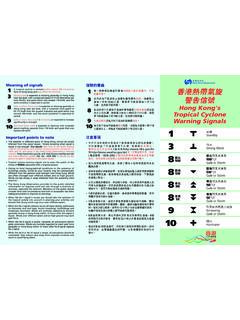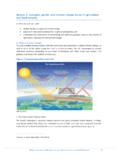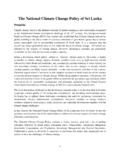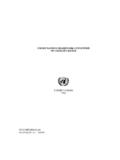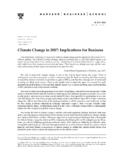Transcription of Reprint 915 Sea-level Rise and Storm Surge – …
1 Reprint 915 Sea-level Rise and Storm Surge Impacts of climate change on Hong Kong Lee, Wong & Woo HKIE Civil Division Conference 2010, 12-14 April 2010, Hong Kong - 1 - Sea-level Rise and Storm Surge Impacts of climate change on Hong Kong B Y Lee, W T Wong and W C Woo Hong Kong Observatory ABSTRACT: A direct consequence of global warming is thermal expansion of sea water and melting of glaciers and ice caps. Both effects would lead to a rise of the mean Sea-level . IPCC s fourth assessment report published in 2007 predicted that the Sea-level could rise by metre in the 21st century while some recent studies suggested that the amount could be even higher - at one to two metres. In addition to potential inundation to coastal low-lying areas, a rise of the mean Sea-level means that extreme sea- levels due to Storm surges caused by tropical cyclones would become more frequent. In this report, we shall take a look at the latest predictions of mean Sea-level for this century, revisit recent Storm Surge events experienced in Hong Kong, and examine the possible impacts of Sea-level rise in light of climate change .
2 1. INTRODUCTION Instrumental record of global surface temperature taken since the 1850s indicates that the Earth is warming up, at a rate that has increased in the past few decades. Such warming is very likely caused by anthropogenic emission of greenhouse gases. Observations since the 1960s show that the average temperature of the global ocean has increased to depths of at least 3000 metres, contributing to Sea-level rise through thermal expansion of the sea water (IPCC, 2007). Indications are that global mountain glaciers and snow cover have declined on average, transferring volumes of land water to the sea and contributing to Sea-level rise. Sea-level rise is of considerable interest because of its potential impact on large populations of people living in coastal regions and on islands. With anticipated further increase of atmospheric greenhouse gases in the next few decades, which will remain in the atmosphere for many years, global surface temperatures would continue to rise resulting in further rise of the Sea-level .
3 In the next few decades, the impact of Sea-level change on societies is expected to primarily manifest itself through extreme events rather than as a direct consequence of a rising mean Sea-level . With the exception of tsunamis which are non-climatic events, extreme sea- levels for this part of the world occur mainly in the form of Storm surges generated by tropical or - 2 - extra-tropical cyclones. Located at the coast of the South China Sea, Hong Kong is affected by about 6 tropical cyclones every year on average. Historically, Storm Surge have caused severe sea flooding and damages in Hong Kong during the passage of typhoons. With a raised Sea-level , the chance and scale of sea flooding due to Storm Surge brought about by typhoons would very likely increase in the future. 2. PAST Sea-level RISE On time scales of decades and longer, global mean Sea-level change mainly arises from two processes, (i) thermal expansion of water volume in the global ocean; and (ii) exchange of water between oceans and land storage (such as glaciers, and ice caps; glaciers are conveniently called mountain ice in such areas as the Himalayas and Alaska, whereas the great ice caps on Greenland and the Antarctic are land ice ).
4 Both of these processes are related to the climate change now underway. On shorter time scales, non-uniform changes in temperature and salinity and the related changes in ocean circulation, and the uneven exchange of water among land, ocean and atmosphere give rise to spatial variation in the magnitude of Sea-level change . Such spatial variability is seen in numerical climate modelling outputs, as well as satellite data and hydrographical observations. Figure 1. Annual averages of the global mean sea level based on reconstructed sea level fields since 1870 (red), tide gauge measurements since 1950 (blue) and satellite altimetry since 1992 (black). Units are in millimetres relative to the average for 1961 to 1990 (IPCC, 2007). - 3 - According to the fourth assessment report (AR4) of the United Nations Intergovernmental Panel on climate change (IPCC), the global mean Sea-level rose at a rate of mm per year for 1961-2003 and mm per year for 1993-2003 (IPCC, 2007).
5 In Hong Kong, tide gauge records in the Victoria Harbour since the 1950s indicate a rise of the mean Sea-level in the past half a century. The trend is similar to that observed by satellite remote sensing over the South China Sea since the early 1990s as well as on tide gauge records at other coastal stations in the region (Wong et al., 2003). During the period 1954 to 2009, the mean Sea-level in the Victoria Harbour has risen about 14 cm (or an average rate of about mm per year). 3. PROJECTION INTO THE FUTURE Projected warming due to emission of greenhouse gases during the 21st century will continue to contribute to Sea-level rise because of thermal expansion and loss of mountain and land ices. Global mean Sea-level rise is projected using numerical Atmosphere-Ocean General Circulation Models. These models include dynamical components describing atmospheric, oceanic and land surface processes, as well as sea ice and other components.
6 There are over 20 models from various national climate centres used to simulate the climate . According to IPCC s AR4, contributions to the sea level are expected from: thermal expansion of up to metre, mountain ice of up to metre and Greenland of up to metre, while the Antarctic is expected to gain in mass due to increased snowfall. Taking account of the uncertainties, the global sea level is projected to rise by the end of the 21st century up to metre compared with that at the end of the last century (IPCC, 2007). The above IPCC predictions are based on numerical climate models which have successfully explained the global Sea-level rise observed in 1993-2003 and reported in the Working Group I contribution The Physical Science Basis under AR4. They are not related in any way to the mistake admitted by IPCC in early 2010 in the estimates of the rate of recession and date for the disappearance of Himalayan glaciers that appear in the Working Group II contribution Impacts, Adaptation and Vulnerability (IPCC, 2010).
7 (Such mistake does not affect IPCC s overall assessment on climate change .) Melting of mountain ice is expected to continue because of global warming. Over the past few years, both Greenland and the Antarctic were found to be losing ice at a much faster rate (Gu finna A algeirsd ttir, 2008; Rignot et al., 2008). Melting of such land ice is a major concern in climate change studies as they together hold enough water to raise the sea level by 70 metres. The numerical climate models mentioned earlier on did not - 4 - include ice flow dynamical processes which are responsible for the observed ice loss in Greenland and the Antarctic as the mechanism of these processes are not fully understood. IPCC s AR4 estimated that if contributions from such land ice masses were to grow linearly with the global average temperature change , the sea level is estimated to rise by a further to metre.
8 A recent study suggested that glacier melt alone (excluding the Greenland and Antarctic ice sheets) may raise the sea level to metre by the end of the 21st century (Meier et al., 2007), which is higher than the prediction in IPCC s AR4. That is, the global sea level may rise by much more than metre above that of the last century. Other attempts to predict the future Sea-level rise include a recent study that relates the global average Sea-level to temperature. By establishing a correlation between these two physical quantities for the past 120 years, the projection gives a maximum Sea-level rise of metres by the end of the 21st century (Rahmstorf, 2007). Some others commented that lubrication of glaciers by melt water would constitute multiple positive feedbacks for the future and raise the upper bound of Sea-level rise to 2 metres (Pfeffer et al., 2008). On the basis of these more recent studies, it now looks likely that the Sea-level rise estimates given in IPCC s AR4 may be conservative.
9 4. Storm SURGES IN HONG KONG Impacts of Sea-level rise to coastal cities include extensive coastal inundation, increased coastal erosion, higher Storm Surge flooding, landward intrusion of seawater in estuaries, and changes in surface water quality and groundwater characteristics. The major impact to Hong Kong would be a possible increase in frequency and scale of sea flooding from Storm surges brought about by tropical cyclones. The highest sea levels recorded in Hong Kong were caused by Storm surges associated with tropical cyclones. For tropical cyclones that came close to Hong Kong, the associated Storm surges would typically raise the sea level by to metre. This is high enough to cause sea flooding if the Storm Surge occurs near the astronomical high tide. In extreme cases in the past, the sea level could exceed the tide level by more than 3 metres, bringing serious sea flooding to coastal low-lying areas.
10 Well-known cases of serious sea flooding due to Storm surges in the past 50 years include Typhoon Wanda in 1962 and Typhoon Ellen in 1983. The most recent cases of inundation due to Storm surges were caused by Typhoon Hagupit and Typhoon Koppu in 2008 and 2009 respectively. - 5 - On 23 September 2008, Typhoon Hagupit, the strongest tropical cyclone that affected Hong Kong in 2008 passed about 180 kilometres south-southwest of Hong Kong and necessitated the issuance of the number 8 gales or Storm force winds signal in Hong Kong. It brought about a Storm Surge of metres at the Victoria Harbour, raising the sea level to a height of metres above Chart Datum (CD) a few hours before high tide. This is the second highest sea level recorded at the Victoria Harbour since the Second World War, after the record high of metres during the passage of Typhoon Wanda in 1962.
